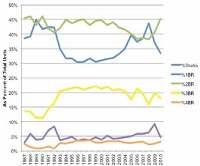Size Matters in Housing Design

The objective of this paper is to provide a context for assisted housing requirements. Ultimately, understanding the history of dwelling-size changes can help architects anticipate future constraints and help make adaptive changes to the design of buildings that were created in the context of past requirements. The paper begins with a literature review of policies and precedents that have shaped housing size (both assisted and market-rate). It continues with a description of housing size trends in the private housing market and Low Income Housing Tax Credit assisted housing stock.
This analysis shows that the size changes are the result of four driving factors: building and health codes, market conditions, federal regulations, and local housing preferences. The paper includes an empirical analysis of Low Income Housing Tax Credit dwelling size that reveals the quantitative results of the driving factors. The paper concludes with an explanation of both how and why the assisted dwelling size has varied from year to year.
keywords: Housing, LIHTC, Crowding dwelling, Subsidized


Add comment
Log in to post comments